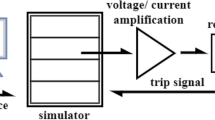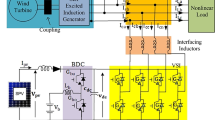Abstract
The presence of partially rated power electronic converters makes the doubly fed induction generator (DFIG)-based wind energy conversion systems (WECS) prominent. This paper focuses on an enhanced low voltage ride-through (LVRT) with reactive power support for WECS based on DFIG during unbalanced type-B and type-E grid voltage dips with the proposed negative sequence control technique. A variety of unbalanced voltage dips will happen in the power system due to different faults which are to be efficiently encountered as per the grid code requirements. WECS with DFIG can be regulated for different types of asymmetrical voltage dips for providing LVRT, by the proposed control of rotor-side-converter (RSC) and grid-side-converter (GSC). Simulations are carried out under MATLAB/Simulink environment for the performance analysis of 2 MW DFIG-based three blade wind turbine. Hardware emulation is executed under a real-time hardware-in-the-loop platform. The proposed control scheme for RSC and GSC shows an improved LVRT capability of WECS based on DFIG with reactive power support to the grid during unbalanced type-B and type-E voltage dips.





























Similar content being viewed by others
Abbreviations
- A :
-
Area of wind turbine blades in m2
- β :
-
Pitch angle of blade
- ρ :
-
Air density (1.225 kg/m3)
- C p :
-
Power-coefficient
- C pmax :
-
Crest value of power-coefficient
- P w :
-
Power developed by the turbine
- R :
-
Radius of wind turbine rotor
- ω :
-
Speed of rotation in rad/sec
- T ref :
-
Torque reference
- V :
-
Speed of wind in m/sec
- λ :
-
Tip-speed-ratio
- λ opt :
-
Optimal tip-speed-ratio
- p :
-
Pole pairs
- L m :
-
Magnetizing inductance
- i r and i s :
-
Currents in rotor and stator
- v s and v r :
-
Voltage of stator and rotor
- R r and R s :
-
Resistance of rotor and stator
- φ r and φ s :
-
Stator and rotor flux referred to stator-side
- L s and L r :
-
Self-inductance of stator and rotor
- i drp and i qrp :
-
Positive sequence of dq rotor currents
- i dgp and i qgp :
-
Positive sequence of dq grid currents
- i drn and i qrn :
-
Negative sequence of dq rotor currents
- i dgn and i qgn :
-
Negative sequence of dq grid currents
References
Ochoa D, Martinez S (2017) Fast-frequency response provided by DFIG-wind turbines and its impact on the grid. IEEE Trans Power Syst 32(5):4002–4011. https://doi.org/10.1109/TPWRS.2016.2636374
Global Wind Energy Council. [Online]. Available: https://www.gwec.net/. Accessed 15 Feb 2021
Bu S, Du W, Wang H (2017) Model validation of DFIGs for power system oscillation stability analysis. IET Renew Power Gener 11(6):858–866. https://doi.org/10.1049/iet-rpg.2016.0980
Tang H, Chi Y, Tian X (2019) Li Y (2019) Power oscillation coordination damping control strategy of DFIG for fault ride through after clearing the fault. J Eng 16:2216–2218. https://doi.org/10.1049/joe.2018.8427
Xu Y, Nian H, Wang T, Chen L, Zheng T (2018) Frequency coupling characteristic modeling and stability analysis of doubly fed induction generator. IEEE Trans Energy Convers 33(3):1475–1486. https://doi.org/10.1109/TEC.2018.2800043
El-Naggar A, Erlich I (2017) Short-circuit current reduction techniques of the doubly-fed induction generator based wind turbines for fault ride through enhancement. IET Renew Power Gener 11(7):1033–1040. https://doi.org/10.1049/iet-rpg.2016.0372
Fathabadi H (2017) Novel maximum electrical and mechanical power tracking controllers for wind energy conversion systems. IEEE J Emerg Sel Top Power Electron 5(4):1739–1745. https://doi.org/10.1109/JESTPE.2017.2727978
Bin Wu, Lang Y, Zargari N, Kouro S (2011) Power conversion and control of wind energy systems. Wiley, Hoboken
Altun H, Sünter S (2013) Modeling, simulation and control of wind turbine driven doubly-fed induction generator with matrix converter on the rotor side. Electr Eng 95:157–170. https://doi.org/10.1007/s00202-012-0250-x
Bollen MHJ (2000) Understanding power quality problems: voltage sags and interruptions. IEEE Press
Shen Y, Ke D, Qiao W, Sun Y, Kirschen DS, Wei C (2015) Transient reconfiguration and coordinated control for power converters to enhance the LVRT of a DFIG wind turbine with an energy storage device. IEEE Trans Energy Convers 30(4):1679–1690. https://doi.org/10.1109/TEC.2015.2449900
Cardenas R, Pena R, Alepuz S, Asher G (2013) Overview of control systems for the operation of DFIGs in wind energy applications. IEEE Trans Industr Electron 60(7):2776–2798. https://doi.org/10.1109/TIE.2013.2243372
Eltamaly AM, Al-Saud MS, Abo-Khalil AG (2020) Dynamic control of a DFIG wind power generation system to mitigate unbalanced grid voltage. IEEE Access 8:39091–39103. https://doi.org/10.1109/ACCESS.2020.2976195
Draft Report on Indian Wind Grid Code, [Online].Available: https://niwe.res.in/NIWE_OLD/Hindi/Docu/Wind_grid_code_for_India%20.pdf Accessed 2 Feb 2019
Din Z, Zhang J, Zhu Y, Xu Z, El-Naggar A (2019) Impact of grid impedance on LVRT performance of DFIG system with rotor crowbar technology. IEEE Access 7:127999–128008. https://doi.org/10.1109/ACCESS.2019.2938207
Thomas T, Prince A (2019) Analysis and validation of low voltage ride-through capability for DFIG based wind energy conversion system under symmetrical grid voltage sags. In: 2019 IEEE international conference on power electronics applications and technology in present energy scenario (PETPES), 29–31 Aug 2019, pp 1–6 https://doi.org/10.1109/PETPES47060.2019.9003815
Thomas T, Prince A (2020) LVRT capability evaluation of DFIG based wind energy conversion system under type-A and type-C grid voltage sags. In: 2020 IEEE international conference on power electronics, smart grid and renewable energy (PESGRE2020), 2–4 Jan 2020, pp 1–6 https://doi.org/10.1109/PESGRE45664.2020.9070540.
Firouzi M, Gharehpetian GB (2018) LVRT performance enhancement of DFIG-based wind farms by capacitive bridge-type fault current limiter. IEEE Trans Sustain Energy 9(3):1118–1125. https://doi.org/10.1109/TSTE.2017.2771321
Liu R, Yao J, Wang X, Sun P, Pei J, Hu J (2020) Dynamic stability analysis and improved LVRT schemes of DFIG-based wind turbines during a symmetrical fault in a weak grid. IEEE Trans Power Electron 35(1):303–318. https://doi.org/10.1109/TPEL.2019.2911346
Ibrahim AO, Nguyen TH, Lee D, Kim S (2011) A fault ride-through technique of DFIG wind turbine systems using dynamic voltage restorers. IEEE Trans Energy Convers 26(3):871–882. https://doi.org/10.1109/TEC.2011.2158102
Okedu KE (2020) (2020) Determination of the most effective switching signal and position of braking resistor in DFIG wind turbine under transient conditions. Electr Eng 102:471–480. https://doi.org/10.1007/s00202-019-00888-5
Chen L et al (2019) Combined use of a resistive SFCL and DC-link regulation of a SMES for FRT enhancement of a DFIG wind turbine under different faults. IEEE Trans Appl Superconduct 29(2):1–8. https://doi.org/10.1109/TASC.2018.2881988
Salama HS, Aly MM, Abdel-Akher M et al (2019) Frequency and voltage control of microgrid with high WECS penetration during wind gusts using superconducting magnetic energy storage. Electr Eng 101:771–786. https://doi.org/10.1007/s00202-019-00821-w
Zheng Z, Huang C, Yang R, Xiao X, Li C (2019) A low voltage ride through scheme for DFIG-based wind farm with SFCL and RSC control. IEEE Trans Appl Superconduct 29(2):1–5. https://doi.org/10.1109/TASC.2019.2891687
Brekken T, Mohan N, Undeland T (2005) Control of a doubly-fed induction wind generator under unbalanced grid voltage conditions. In: 2005 european conference on power electronics and applications, Dresden 10:10 https://doi.org/10.1109/EPE.2005.219315
Li L, Nian H, Ding L, Zhou B (2018) Direct power control of DFIG system without phase-locked loop under unbalanced and harmonically distorted voltage. IEEE Trans Energy Convers 33(1):395–405. https://doi.org/10.1109/TEC.2017.2741473
Leon AE, Mauricio JM, Solsona JA (2012) Fault ride-through enhancement of DFIG-based wind generation considering unbalanced and distorted conditions. IEEE Trans Energy Convers 27(3):775–783. https://doi.org/10.1109/TEC.2012.2204756
Villanueva I, Rosales A, Ponce P, Molina A (2018) Grid-voltage-oriented sliding mode control for DFIG under balanced and unbalanced grid faults. IEEE Trans Sustain Energy 9(3):1090–1098. https://doi.org/10.1109/TSTE.2017.2769062
Elnaghi BE, Elkader FA, Ismail MM et al (2018) Adaptation of PI controller used with combination of perturbation and observation method and feedback method for DFIG. Electr Eng 100:1047–1058. https://doi.org/10.1007/s00202-017-0565-8
Shihabudheen KV, Raju SK, Pillai GN (2018) Control for grid-connected DFIG-based wind energy system using adaptive neuro-fuzzy technique. Int Trans Electr Energ Syst 2018:e2526. https://doi.org/10.1002/etep.2526
Martinez MI, Susperregui A, Tapia G (2017) Second-order sliding-mode-based global control scheme for wind turbine-driven DFIGs subject to unbalanced and distorted grid voltage. IET Electr Power Appl 11(6):1013–1022. https://doi.org/10.1049/iet-epa.2016.0711
Thomas T, Asok P (2020) (2020) Event analysis and real-time validation of doubly fed induction generator-based wind energy system with grid reactive power exchange under sub-synchronous and super-synchronous modes. Eng Rep 2:e12282. https://doi.org/10.1002/eng2.12282
Abad G, Lopez J, Rodriguez M, Marroyo L, Iwanski G (2011) Doubly fed induction machine: modeling and control for wind energy generation. Wiley, Hoboken
Thomas T, Cheriyan EP (2012) Wind energy system for a laboratory scale micro-grid. In: Proc IEEE Students Conf on Elect Electron and Computer Science, March 2012, pp 1–5 https://doi.org/10.1109/SCEECS.2012.6184761
Machowski J, Lubosny Z, Bialek JW, Bumby JR (2020) Power system dynamics: stability and control. Wiley
Acknowledgements
Authors acknowledge the aid from the Centre for Engineering Research and Development (CERD), Kerala, India.
Author information
Authors and Affiliations
Corresponding author
Additional information
Publisher's Note
Springer Nature remains neutral with regard to jurisdictional claims in published maps and institutional affiliations.
Rights and permissions
About this article
Cite this article
Thomas, T., Prince, A., Kumar, P.R.S. et al. Real-time hardware emulation of WECS based on DFIG during unbalanced type-B and type-E voltage dips for enhanced low voltage ride-through. Electr Eng 104, 3717–3732 (2022). https://doi.org/10.1007/s00202-022-01577-6
Received:
Accepted:
Published:
Issue Date:
DOI: https://doi.org/10.1007/s00202-022-01577-6




